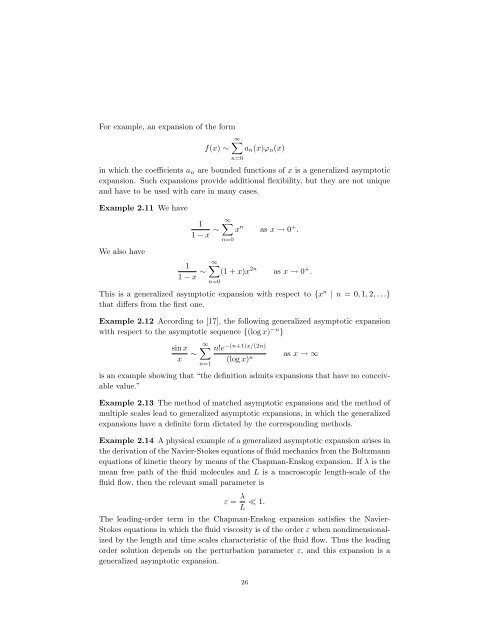Asymptotic Analysis and Singular Perturbation Theory
Asymptotic Analysis and Singular Perturbation Theory
Asymptotic Analysis and Singular Perturbation Theory
Create successful ePaper yourself
Turn your PDF publications into a flip-book with our unique Google optimized e-Paper software.
For example, an expansion of the form<br />
∞<br />
f(x) ∼ an(x)ϕn(x)<br />
n=0<br />
in which the coefficients an are bounded functions of x is a generalized asymptotic<br />
expansion. Such expansions provide additional flexibility, but they are not unique<br />
<strong>and</strong> have to be used with care in many cases.<br />
Example 2.11 We have<br />
We also have<br />
1<br />
1 − x ∼<br />
1<br />
1 − x ∼<br />
∞<br />
x n<br />
n=0<br />
∞<br />
(1 + x)x 2n<br />
n=0<br />
as x → 0 + .<br />
as x → 0 + .<br />
This is a generalized asymptotic expansion with respect to {x n | n = 0, 1, 2, . . .}<br />
that differs from the first one.<br />
Example 2.12 According to [17], the following generalized asymptotic expansion<br />
with respect to the asymptotic sequence {(log x) −n }<br />
sin x<br />
x ∼<br />
∞ n!e−(n+1)x/(2n) n=1<br />
(log x) n<br />
as x → ∞<br />
is an example showing that “the definition admits expansions that have no conceivable<br />
value.”<br />
Example 2.13 The method of matched asymptotic expansions <strong>and</strong> the method of<br />
multiple scales lead to generalized asymptotic expansions, in which the generalized<br />
expansions have a definite form dictated by the corresponding methods.<br />
Example 2.14 A physical example of a generalized asymptotic expansion arises in<br />
the derivation of the Navier-Stokes equations of fluid mechanics from the Boltzmann<br />
equations of kinetic theory by means of the Chapman-Enskog expansion. If λ is the<br />
mean free path of the fluid molecules <strong>and</strong> L is a macroscopic length-scale of the<br />
fluid flow, then the relevant small parameter is<br />
ε = λ<br />
≪ 1.<br />
L<br />
The leading-order term in the Chapman-Enskog expansion satisfies the Navier-<br />
Stokes equations in which the fluid viscosity is of the order ε when nondimensionalized<br />
by the length <strong>and</strong> time scales characteristic of the fluid flow. Thus the leading<br />
order solution depends on the perturbation parameter ε, <strong>and</strong> this expansion is a<br />
generalized asymptotic expansion.<br />
26
















